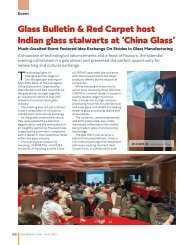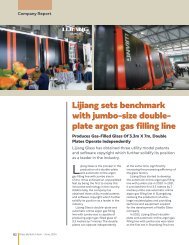Edition 57 (Jan-Mar, 2020)
Create successful ePaper yourself
Turn your PDF publications into a flip-book with our unique Google optimized e-Paper software.
glaston • 2
– long side leading and short side
leading in the same pattern but with a
different orientation.
Mixing up the loading patterns
with different glass orientation – short
versus long edge leading – will result in
different optical quality. If these glasses
are installed in the same building,
you’ll see a different optical reflection
and, most likely as a result, end up
with a reclamation. This is a common
rookie mistake. So make sure to avoid
it.
Don’t get me wrong, maximizing
loading efficiency is a good thing, and
it will increase your energy efficiency
as well. The point is not to compromise
the quality.
4. Having a heating time that
is too long
The percentage of glass breakage has
been a tempering line operator’s most
important KPI for a long time. For
this reason, operators naturally do
everything they can to decrease the
waste.
One way to prevent breakage is to
increase the heating time. This will,
unfortunately, have a negative impact
on the glass quality. The higher the
glass temperature is, the worse the
quality.
Note that quite often operators think
that poor cutting or grinding quality
comes from having a temperature that
is too low in the tempering process. In
this case, the operator is correcting the
wrong problem and, as a result, has
poor quality glass with poor edge work.
5. Running thick and thin
glass in a similar way
Avoid putting a thick piece of glass into
a very hot furnace. Trust me, you don’t
want to hear the “Boom!” That is the
noise of a thick glass breaking in the
furnace. In this case, the breakage is
caused by heat shock. As a result, the
furnace needs to be cooled, and the
broken glass removed.
As a kind reminder, this process
takes about two shifts to complete.
Also, when running a thick glass of
around 10–19 mm, the quenching
pressure the operators are applying is
often too low. A common rule is that
low pressure prevents the glass from
breaking in the chiller. Most often, the
case is almost the opposite. So don’t
use pressure that is too low in the
production of thick glass.
6. Removing the ghost the
wrong way
Many operators try to fix the white
haze issue by operating the line to run
the glass “sad” in the furnace. In other
words, the corners of the glass touch
the rollers but the centre does not. Yes,
this does eliminate the white haze,
also known as “ghosting.” But running
thick glass “sad” will harm the rollers.
The ghosting can chip off some glass
from the sides or cause markings to the
rollers. As a result, the following loads
will have problems and the thin glasses
will not stay stable.
Here’s my rule of thumb: don’t
exaggerate the sadness of the glass.
Conclusion
It seems that as we become more
comfortable with our work, the more
mistakes we make. And the more you
think you know something, the more
likely it is that your choices lead you
down the wrong path. That’s why even
us experts should always keep the
basics in mind.
If you have some unanswered
questions about tempering, I
recommend downloading our free
eBook. It will give you more basics –
and then some.
Author:
Mr. Sami Kelin, Product Director, Glaston Heat
treatment technologies
--------------------------------------------------
Sorce: www.glastory.net
--------------------------------------------------
Email: info@glaston.net
Website: www.glaston.net
Glass Bulletin | January - March, 2020 71


















